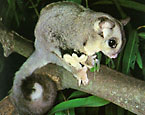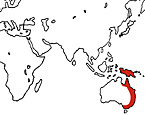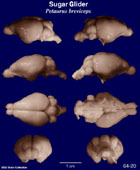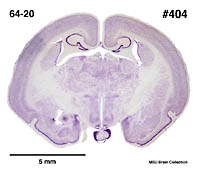|
Sugar
Glider
(Petaurus breviceps) #64-20 |
||||
|
|
Physical
characteristics and distribution
|
|
The Sugar Glider is a relatively small marsupial; its head
and body are approximately 120-320mm long and the tail has
a length of 150-480mm. Sugar Gliders are generally blue-greyish
dorsally while their ventral surfaces are somewhat paler.
A dark stripe runs down the back from the posterior end to
the nose, while similar stripes are located on each side of
the face running from the eye to the ear. Much like Flying
Squirrels, Sugar Gliders have a gliding membrane which extends
from the outer side of the fore foot to the ankle of the rear
foot and may be opened by spreading out the limbs. The prehensile
tails are furred all around and in this species are used to
transport leaves for nest material. Sugar Gliders can glide
up to 45 meters and has been observed catching moths in flight.
Sugar Gliders can live in forests of all types, given that there is an adequate food supply. They build their nests in the branches of eucalyptus trees inside their territory. They are omnivorous, favoring sap, nectar small insects and larvae, arachnids, and small vertebrates. Nesting
is done in groups of up to seven males and females and their
young, most likely all from the same original colonizing pair.
Nesting groups seem to be mutually exclusive and territorial.
Two of the most dominant males protect against intruders and
father the group's young. The young usually leave the group
at 10 -12 months of age. A highly developed communication
system relies on individual scents produced by frontal, sternal
and urogenital glands of males and pouch and urogenital glands
of females. Scents mark the territory inhabited by the group
and in addition, the dominant male scent marks the other members
of the group. Petaurus breviceps is found in SE South Australia to Cape York Peninsula (Queensland), Tasmania (introduction), N Northern Territory, NE Western Australia; New Guinea and adjacent small islands, including Bismarck Arch.; Aru Isls and N Moluccas (Indonesia). |
|
Description
of the brain
|
|
Animal
source and preparation
|
|
All
specimens collected followed the same preparation
and histological procedure.
|
Other Related Resources (websites and publications)
List of Specimens | Explore Collections | Brain Sections | Brain Evolution | Brain Development | Brain Circuitry | Brain Functions | Location and Use | Related Web Sites | Contact Us | Search MSU Database | Personnel | Home



